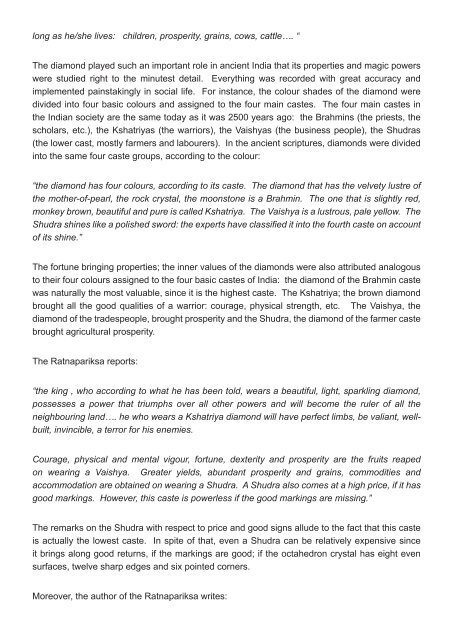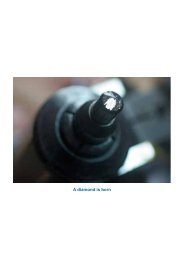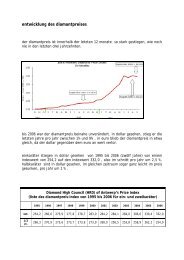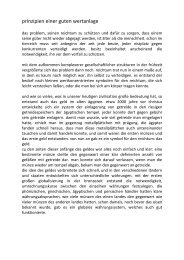The diamond in ancient India - Diamantschleiferei Michael Bonke
The diamond in ancient India - Diamantschleiferei Michael Bonke
The diamond in ancient India - Diamantschleiferei Michael Bonke
- No tags were found...
You also want an ePaper? Increase the reach of your titles
YUMPU automatically turns print PDFs into web optimized ePapers that Google loves.
long as he/she lives: children, prosperity, gra<strong>in</strong>s, cows, cattle…. “<strong>The</strong> <strong>diamond</strong> played such an important role <strong>in</strong> <strong>ancient</strong> <strong>India</strong> that its properties and magic powerswere studied right to the m<strong>in</strong>utest detail. Everyth<strong>in</strong>g was recorded with great accuracy andimplemented pa<strong>in</strong>stak<strong>in</strong>gly <strong>in</strong> social life. For <strong>in</strong>stance, the colour shades of the <strong>diamond</strong> weredivided <strong>in</strong>to four basic colours and assigned to the four ma<strong>in</strong> castes. <strong>The</strong> four ma<strong>in</strong> castes <strong>in</strong>the <strong>India</strong>n society are the same today as it was 2500 years ago: the Brahm<strong>in</strong>s (the priests, thescholars, etc.), the Kshatriyas (the warriors), the Vaishyas (the bus<strong>in</strong>ess people), the Shudras(the lower cast, mostly farmers and labourers). In the <strong>ancient</strong> scriptures, <strong>diamond</strong>s were divided<strong>in</strong>to the same four caste groups, accord<strong>in</strong>g to the colour:“the <strong>diamond</strong> has four colours, accord<strong>in</strong>g to its caste. <strong>The</strong> <strong>diamond</strong> that has the velvety lustre ofthe mother-of-pearl, the rock crystal, the moonstone is a Brahm<strong>in</strong>. <strong>The</strong> one that is slightly red,monkey brown, beautiful and pure is called Kshatriya. <strong>The</strong> Vaishya is a lustrous, pale yellow. <strong>The</strong>Shudra sh<strong>in</strong>es like a polished sword: the experts have classified it <strong>in</strong>to the fourth caste on accountof its sh<strong>in</strong>e.”<strong>The</strong> fortune br<strong>in</strong>g<strong>in</strong>g properties; the <strong>in</strong>ner values of the <strong>diamond</strong>s were also attributed analogousto their four colours assigned to the four basic castes of <strong>India</strong>: the <strong>diamond</strong> of the Brahm<strong>in</strong> castewas naturally the most valuable, s<strong>in</strong>ce it is the highest caste. <strong>The</strong> Kshatriya; the brown <strong>diamond</strong>brought all the good qualities of a warrior: courage, physical strength, etc. <strong>The</strong> Vaishya, the<strong>diamond</strong> of the tradespeople, brought prosperity and the Shudra, the <strong>diamond</strong> of the farmer castebrought agricultural prosperity.<strong>The</strong> Ratnapariksa reports:“the k<strong>in</strong>g , who accord<strong>in</strong>g to what he has been told, wears a beautiful, light, sparkl<strong>in</strong>g <strong>diamond</strong>,possesses a power that triumphs over all other powers and will become the ruler of all theneighbour<strong>in</strong>g land…. he who wears a Kshatriya <strong>diamond</strong> will have perfect limbs, be valiant, wellbuilt,<strong>in</strong>v<strong>in</strong>cible, a terror for his enemies.Courage, physical and mental vigour, fortune, dexterity and prosperity are the fruits reapedon wear<strong>in</strong>g a Vaishya. Greater yields, abundant prosperity and gra<strong>in</strong>s, commodities andaccommodation are obta<strong>in</strong>ed on wear<strong>in</strong>g a Shudra. A Shudra also comes at a high price, if it hasgood mark<strong>in</strong>gs. However, this caste is powerless if the good mark<strong>in</strong>gs are miss<strong>in</strong>g.”<strong>The</strong> remarks on the Shudra with respect to price and good signs allude to the fact that this casteis actually the lowest caste. In spite of that, even a Shudra can be relatively expensive s<strong>in</strong>ceit br<strong>in</strong>gs along good returns, if the mark<strong>in</strong>gs are good; if the octahedron crystal has eight evensurfaces, twelve sharp edges and six po<strong>in</strong>ted corners.Moreover, the author of the Ratnapariksa writes:









